Unit 16 英汉篇章翻译(一)
- 格式:doc
- 大小:33.50 KB
- 文档页数:3
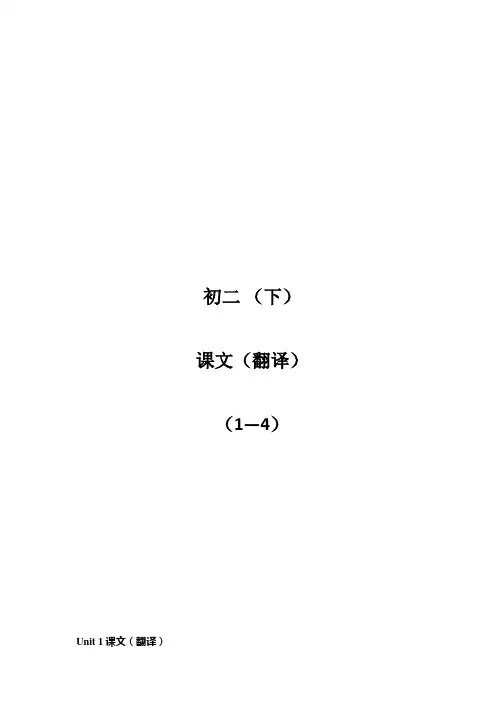
初二(下)课文(翻译)(1—4)Unit 1 课文(翻译)志愿工作Voluntary['vɒlənt(ə)rɪ]志愿的 work三个青少年提出去做一些志愿工作,在学校假期期间。
他们写了以下的报告。
Three teenagers['tiːneɪdʒə]青少年offered ['ɒfə]提出;提供to do some voluntary work during在...期间 the school holidays假期. They wrote the following ['fɒləʊɪŋ]以下的 reports[rɪ'pɔːt]报告.我在儿童医院做了些志愿工作。
那里的儿童都遭受严重的疾病。
我们为他们组织了一个绘画比赛。
I did some voluntary work in a children’s hospital. The children there 那里all suffer from['sʌfə]遭受serious严重的;严肃的illnesses['ɪlnəs]疾病. We organized ['ɔrɡənaɪz]组织 a painting绘画 competition [kɒmpɪ'tɪʃ(ə)n]比赛for them.我遇见一个叫做辛迪的女孩。
她想要画一副她家附近公园的画。
我去那里并拍些照片。
辛迪用它们绘画。
I met a girl called Cindy. She wanted to paint [peɪnt] 画a picture of the park near herhome. I went there and took some photos 拍照of it. Cindy used them for her painting.Betty有很多孩子没有父母。
我和我妈妈遇见过一些这样的孩子,我们教他们讲故事。
这帮助他们表达他们的情感。
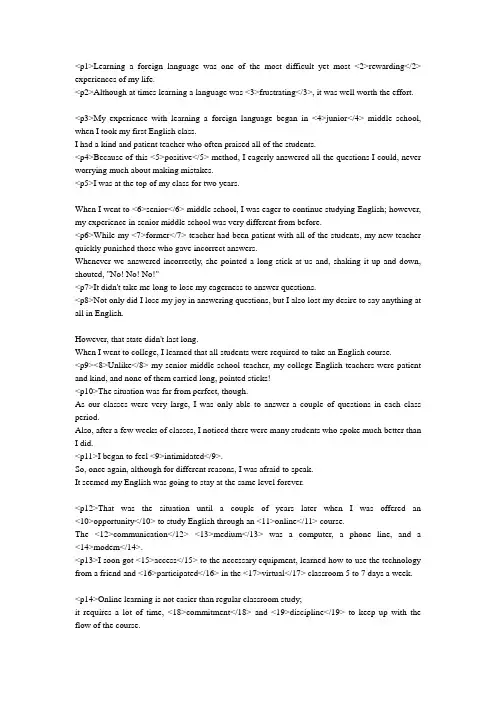
<p1>Learning a foreign language was one of the most difficult yet most <2>rewarding</2> experiences of my life.<p2>Although at times learning a language was <3>frustrating</3>, it was well worth the effort.<p3>My experience with learning a foreign language began in <4>junior</4> middle school, when I took my first English class.I had a kind and patient teacher who often praised all of the students.<p4>Because of this <5>positive</5> method, I eagerly answered all the questions I could, never worrying much about making mistakes.<p5>I was at the top of my class for two years.When I went to <6>senior</6> middle school, I was eager to continue studying English; however, my experience in senior middle school was very different from before.<p6>While my <7>former</7> teacher had been patient with all of the students, my new teacher quickly punished those who gave incorrect answers.Whenever we answered incorrectly, she pointed a long stick at us and, shaking it up and down, shouted, "No! No! No!"<p7>It didn't take me long to lose my eagerness to answer questions.<p8>Not only did I lose my joy in answering questions, but I also lost my desire to say anything at all in English.However, that state didn't last long.When I went to college, I learned that all students were required to take an English course.<p9><8>Unlike</8> my senior middle school teacher, my college English teachers were patient and kind, and none of them carried long, pointed sticks!<p10>The situation was far from perfect, though.As our classes were very large, I was only able to answer a couple of questions in each class period.Also, after a few weeks of classes, I noticed there were many students who spoke much better than I did.<p11>I began to feel <9>intimidated</9>.So, once again, although for different reasons, I was afraid to speak.It seemed my English was going to stay at the same level forever.<p12>That was the situation until a couple of years later when I was offered an <10>opportunity</10> to study English through an <11>online</11> course.The <12>communication</12> <13>medium</13> was a computer, a phone line, and a <14>modem</14>.<p13>I soon got <15>access</15> to the necessary equipment, learned how to use the technology from a friend and <16>participated</16> in the <17>virtual</17> classroom 5 to 7 days a week.<p14>Online learning is not easier than regular classroom study;it requires a lot of time, <18>commitment</18> and <19>discipline</19> to keep up with the flow of the course.<p15>I worked hard to meet the <20>minimum</20> standards set by the course and to complete <21>assignments</21> on time.I practiced all the time.I carried a little dictionary with me everywhere I went, as well as a notebook in which I listed any new words I heard.<p16>I made many, sometimes <23>embarrassing</23>, mistakes.<p17>Once in a while I cried out of <24>frustration</24>, and sometimes I felt like giving up.<p18>But I didn't feel intimidated by students who spoke faster than I did because I took all the time I needed to think out my ideas and wrote a reply before <25>posting</25> it on the screen. <p19>Then, one day I realized I could understand just about everything I came across, and most importantly, I could "say" anything I wanted to in English.<p20>Although I was still making many mistakes and was <27>continually</27> learning new ways to say things, I had finally <28>reaped</28> the <29>benefits</29> of all of my hard work.<p21>Learning a foreign language has been a most trying experience for me, but one that I wouldn't trade for anything.<p22>Not only did learning another language teach me the value of hard work, but it also gave me <30>insights</30> into another culture, and my mind was opened to new ways of seeing things. The most wonderful result of having learned a foreign language was that I could <31>communicate</31> with many more people than before.Talking with people is one of my <32>favorite</32> activities, so being able to speak a new language lets me meet new people, participate in conversations, and form new, unforgettable friendships.<p23>Now that I speak a foreign language, instead of staring into space when English is being spoken,I can participate and make friends.<p24>I am able to reach out to others and bridge the <33>gap</33> between my language and culture and theirs.学习外语是我一生中最艰苦也是最有意义的经历之一。
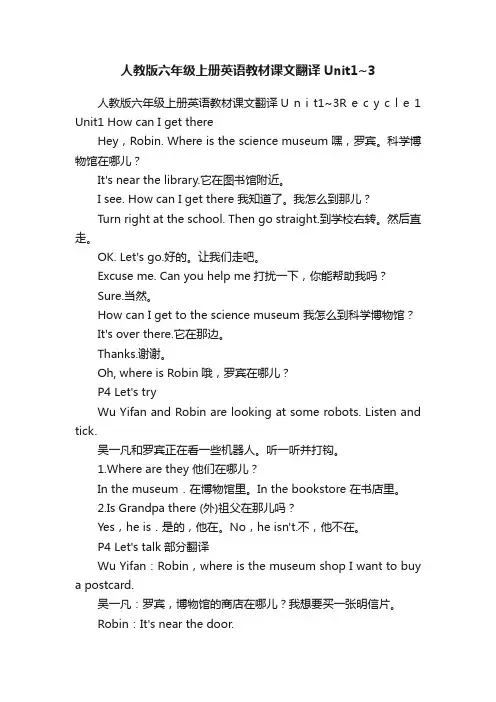
人教版六年级上册英语教材课文翻译Unit1~3人教版六年级上册英语教材课文翻译U n i t1~3R e c y c l e 1 Unit1 How can I get thereHey,Robin. Where is the science museum嘿,罗宾。
科学博物馆在哪儿?It's near the library.它在图书馆附近。
I see. How can I get there 我知道了。
我怎么到那儿?Turn right at the school. Then go straight.到学校右转。
然后直走。
OK. Let's go.好的。
让我们走吧。
Excuse me. Can you help me打扰一下,你能帮助我吗?Sure.当然。
How can I get to the science museum 我怎么到科学博物馆?It's over there.它在那边。
Thanks.谢谢。
Oh, where is Robin哦,罗宾在哪儿?P4 Let's tryWu Yifan and Robin are looking at some robots. Listen and tick.吴一凡和罗宾正在看一些机器人。
听一听并打钩。
1.Where are they 他们在哪儿?In the museum.在博物馆里。
In the bookstore 在书店里。
2.Is Grandpa there (外)祖父在那儿吗?Yes,he is.是的,他在。
No,he isn't.不,他不在。
P4 Let's talk部分翻译Wu Yifan:Robin,where is the museum shop I want to buy a postcard.吴一凡:罗宾,博物馆的商店在哪儿?我想要买一张明信片。
Robin:It's near the door.罗宾:在大门附近。
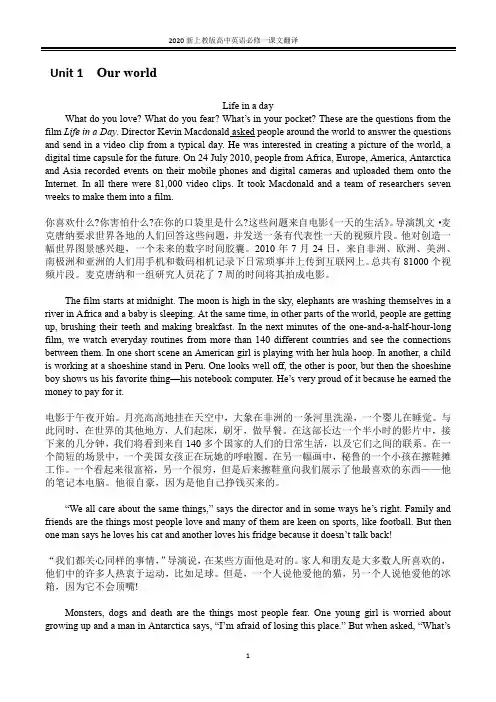
Unit 1 Our worldLife in a dayWhat do you love? What do you fear? What’s in your pocket? These are the questions from the film Life in a Day. Director Kevin Macdonald asked people around the world to answer the questions and send in a video clip from a typical day. He was interested in creating a picture of the world, a digital time capsule for the future. On 24 July 2010, people from Africa, Europe, America, Antarctica and Asia recorded events on their mobile phones and digital cameras and uploaded them onto the Internet. In all there were 81,000 video clips. It took Macdonald and a team of researchers seven weeks to make them into a film.你喜欢什么?你害怕什么?在你的口袋里是什么?这些问题来自电影《一天的生活》。
导演凯文·麦克唐纳要求世界各地的人们回答这些问题,并发送一条有代表性一天的视频片段。
他对创造一幅世界图景感兴趣,一个未来的数字时间胶囊。
2010年7月24日,来自非洲、欧洲、美洲、南极洲和亚洲的人们用手机和数码相机记录下日常琐事并上传到互联网上。
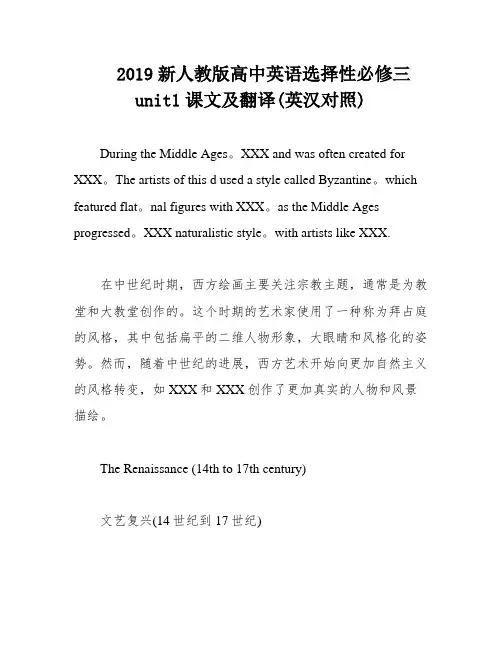
2019新人教版高中英语选择性必修三unit1课文及翻译(英汉对照)During the Middle Ages。
XXX and was often created for XXX。
The artists of this d used a style called Byzantine。
which featured flat。
nal figures with XXX。
as the Middle Ages progressed。
XXX naturalistic style。
with artists like XXX.在中世纪时期,西方绘画主要关注宗教主题,通常是为教堂和大教堂创作的。
这个时期的艺术家使用了一种称为拜占庭的风格,其中包括扁平的二维人物形象,大眼睛和风格化的姿势。
然而,随着中世纪的进展,西方艺术开始向更加自然主义的风格转变,如XXX和XXX创作了更加真实的人物和风景描绘。
The Renaissance (14th to 17th century)文艺复兴(14世纪到17世纪)The Renaissance was a d of great artistic and cultural changein Western Europe。
During this time。
XXX。
XXX。
Some ofthe most famous artists of the Renaissance include Leonardo da Vinci。
Michelangelo。
and Raphael。
These artists created works that were characterized by their n to detail。
use of perspective。
and realistic ns of the human form.文艺复兴是西欧一个伟大的艺术和文化变革时期。
在这个时期,艺术家开始探索新的技术和风格,导致对古典艺术和文化的重新关注。
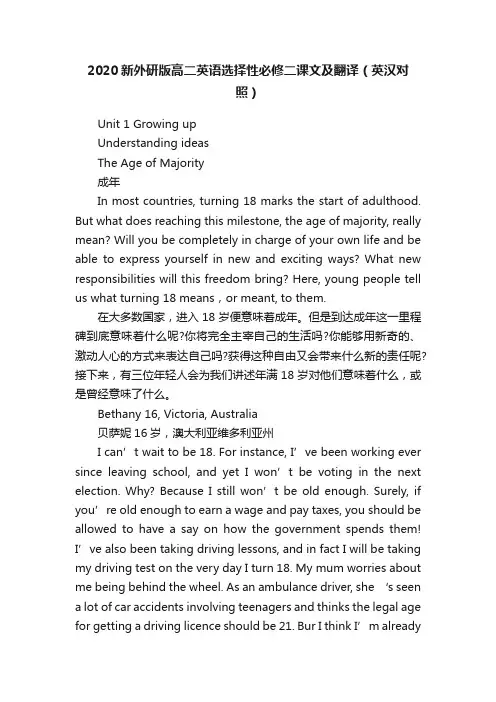
2020新外研版高二英语选择性必修二课文及翻译(英汉对照)Unit 1 Growing upUnderstanding ideasThe Age of Majority成年In most countries, turning 18 marks the start of adulthood. But what does reaching this milestone, the age of majority, really mean? Will you be completely in charge of your own life and be able to express yourself in new and exciting ways? What new responsibilities will this freedom bring? Here, young people tell us what turning 18 means,or meant, to them.在大多数国家,进入18岁便意味着成年。
但是到达成年这一里程碑到底意味着什么呢?你将完全主宰自己的生活吗?你能够用新奇的、激动人心的方式来表达自己吗?获得这种自由又会带来什么新的责任呢?接下来,有三位年轻人会为我们讲述年满18岁对他们意味着什么,或是曾经意味了什么。
Bethany 16, Victoria, Australia贝萨妮16岁,澳大利亚维多利亚州I can’t wait to be 18. For instance, I’ve been working eve r since leaving school, and yet I won’t be voting in the next election. Why? Because I still won’t be old enough. Surely, if you’re old enough to earn a wage and pay taxes, you should be allowed to have a say on how the government spends them! I’ve also be en taking driving lessons, and in fact I will be taking my driving test on the very day I turn 18. My mum worries about me being behind the wheel. As an ambulance driver, she ‘s seen a lot of car accidents involving teenagers and thinks the legal age for g etting a driving licence should be 21. Bur I think I’m alreadymature enough to understand that driving a car also means taking responsibility for my life and the lives of other people.我简直等不及想要到18岁了。
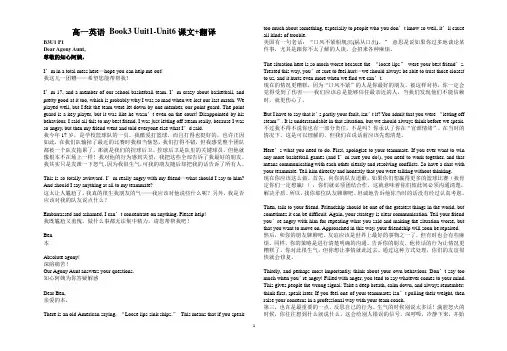
高一英语Book3 Uuit1-Unit6课文+翻译B3U1 P1Dear Agony Aunt,尊敬的知心阿姨,I’m in a total mess here—hope you can help me out!我这儿一团糟——希望您能帮帮我!I’m 17, and a member of our school basketball team. I’m crazy about basketball, and pretty good at it too, which is probably why I was so mad when we lost our last match. We played well, but I felt the team were let down by one member, our point guard. The point guard is a key player, but it was like he wasn’t even on the court! Disappointed by his behaviour, I said all this to my best friend. I was just letting off steam really, because I was so angry, but then my friend went and told everyone else what I’d said.我今年17岁,是学校篮球队的一员。
我酷爱打篮球,而且打得也挺好的,也许正因如此,在我们队输掉了最近的比赛时我相当恼怒。
我们打得不错,但我感觉整个团队都被一个队友拖累了,那就是我们的控球后卫。
控球后卫是队里的关键球员,但他就像根本不在场上一样!我对他的行为感到失望,我把这些全部告诉了我最好的朋友。
我其实只是发泄一下怒气,因为我很生气,可我的朋友随后却把我的话告诉了所有人。
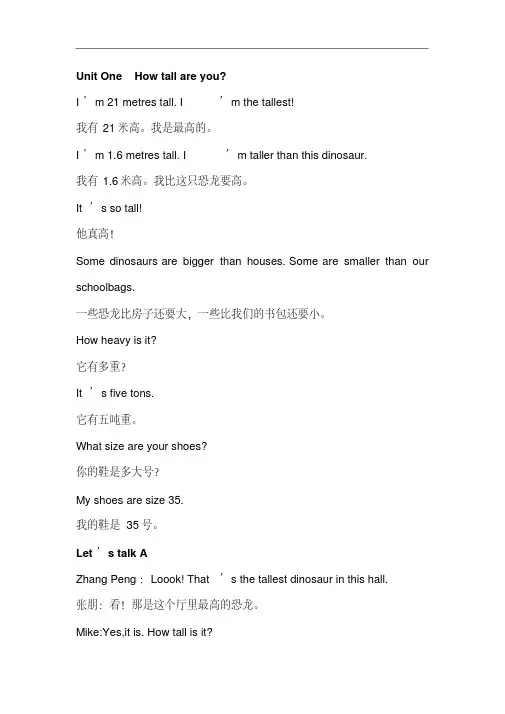
Unit One How tall are you?I’m 21 metres tall. I’m the tallest!我有21米高。
我是最高的。
I’m 1.6 metres tall. I’m taller than this dinosaur.我有1.6米高。
我比这只恐龙要高。
It’s so tall!他真高!Some dinosaurs are bigger than houses. Some are smaller than our schoolbags.一些恐龙比房子还要大,一些比我们的书包还要小。
How heavy is it?它有多重?It’s five tons.它有五吨重。
What size are your shoes?你的鞋是多大号?My shoes are size 35.我的鞋是35号。
Let’s talk AZhang Peng :Loook! That’s the tallest dinosaur in this hall.张朋:看!那是这个厅里最高的恐龙。
Mike:Yes,it is. How tall is it?麦克:是的,它是。
它有多高?Zhang Peng:Maybe 4 metres.张朋:可能有4米高。
Mike:Wow! It’s taller than both of us together.麦克:哇!它比我们俩加起来都高。
Zhang Peng:Look!There are more dinosaurs over there!张朋:看!这里有更多的恐龙!Mike: They’re all so big and tall.麦克:它们全都又高又大。
Zhang Peng:Hey, this dinosaur isn’t tall! I’m taller than this one.张朋:嘿,这只恐龙并不高!我都比这只高。
Mike: Oh, yes. How tall are you?麦克:哦,是的。
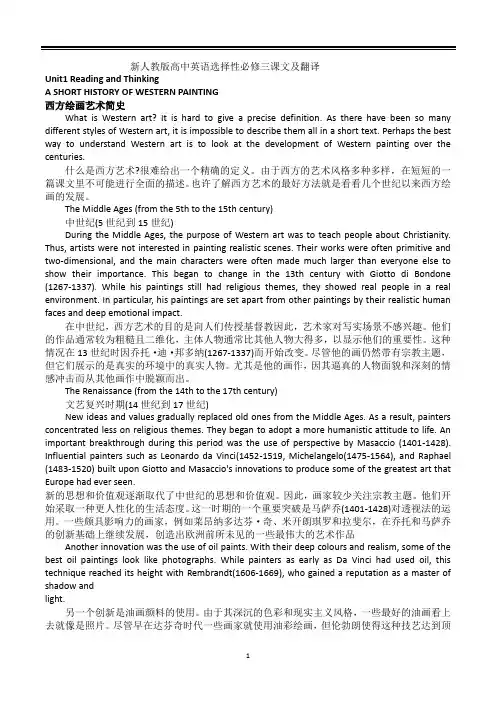
新人教版高中英语选择性必修三课文及翻译Unit1 Reading and ThinkingA SHORT HISTORY OF WESTERN PAINTING西方绘画艺术简史What is Western art? It is hard to give a precise definition. As there have been so many different styles of Western art, it is impossible to describe them all in a short text. Perhaps the best way to understand Western art is to look at the development of Western painting over the centuries.什么是西方艺术?很难给出一个精确的定义。
由于西方的艺术风格多种多样,在短短的一篇课文里不可能进行全面的描述。
也许了解西方艺术的最好方法就是看看几个世纪以来西方绘画的发展。
The Middle Ages (from the 5th to the 15th century)中世纪(5世纪到15世纪)During the Middle Ages, the purpose of Western art was to teach people about Christianity. Thus, artists were not interested in painting realistic scenes. Their works were often primitive and two-dimensional, and the main characters were often made much larger than everyone else to show their importance. This began to change in the 13th century with Giotto di Bondone (1267-1337). While his paintings still had religious themes, they showed real people in a real environment. In particular, his paintings are set apart from other paintings by their realistic human faces and deep emotional impact.在中世纪,西方艺术的目的是向人们传授基督教因此,艺术家对写实场景不感兴趣。
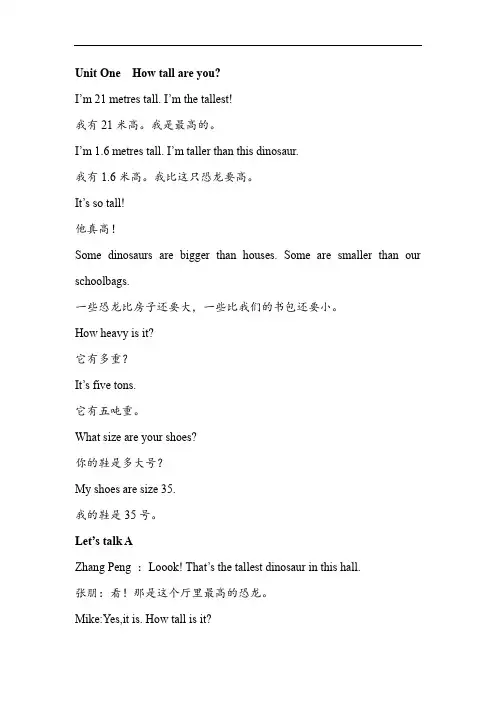
Unit One How tall are you?I’m 21 metres tall. I’m the tallest!我有21米高。
我是最高的。
I’m 1.6 metres tall. I’m taller than this dinosaur.我有1.6米高。
我比这只恐龙要高。
It’s so tall!他真高!Some dinosaurs are bigger than houses. Some are smaller than our schoolbags.一些恐龙比房子还要大,一些比我们的书包还要小。
How heavy is it?它有多重?It’s five tons.它有五吨重。
What size are your shoes?你的鞋是多大号?My shoes are size 35.我的鞋是35号。
Let’s talk AZhang Peng :Loook! That’s the tallest dinosaur in this hall.张朋:看!那是这个厅里最高的恐龙。
Mike:Yes,it is. How tall is it?麦克:是的,它是。
它有多高?Zhang Peng:Maybe 4 metres.张朋:可能有4米高。
Mike:Wow! It’s taller than both of us together.麦克:哇!它比我们俩加起来都高。
Zhang Peng:Look!There are more dinosaurs over there!张朋:看!这里有更多的恐龙!Mike: They’re all so big and tall.麦克:它们全都又高又大。
Zhang Peng:Hey, this dinosaur isn’t tall! I’m taller than this one.张朋:嘿,这只恐龙并不高!我都比这只高。
Mike: Oh, yes. How tall are you?麦克:哦,是的。
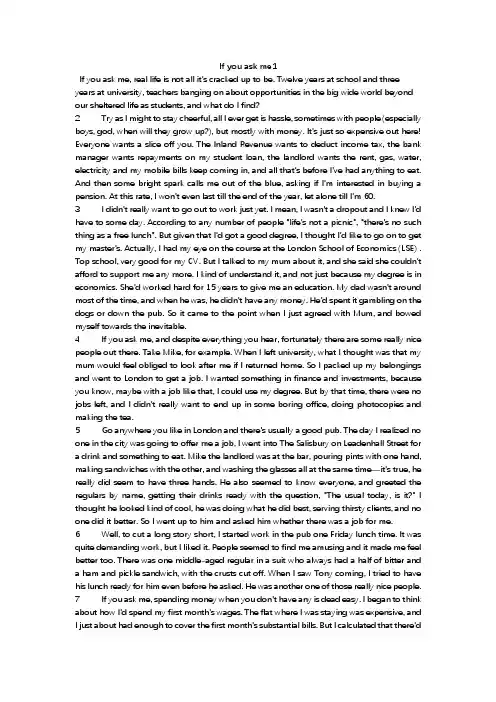
If you ask me1If you ask me, real life is not all it's cracked up to be. Twelve years at school and three years at university, teachers banging on about opportunities in the big wide world beyond our sheltered life as students, and what do I find?2 Try as I might to stay cheerful, all I ever get is hassle, sometimes with people (especially boys, god, when will they grow up?), but mostly with money. It's just so expensive out here! Everyone wants a slice off you. The Inland Revenue wants to deduct income tax, the bank manager wants repayments on my student loan, the landlord wants the rent, gas, water, electricity and my mobile bills keep coming in, and all that's before I've had anything to eat. And then some bright spark calls me out of the blue, asking if I'm interested in buying a pension. At this rate, I won't even last till the end of the year, let alone till I'm 60.3 I didn't really want to go out to work just yet. I mean, I wasn't a dropout and I knew I'd have to some day. According to any number of people "life's not a picnic", "there's no such thing as a free lunch". But given that I'd got a good degree, I thought I'd like to go on to get my master's. Actually, I had my eye on the course at the London School of Economics (LSE) . Top school, very good for my CV. But I talked to my mum about it, and she said she couldn't afford to support me any more. I kind of understand it, and not just because my degree is in economics. She'd worked hard for 15 years to give me an education. My dad wasn't around most of the time, and when he was, he didn't have any money. He'd spent it gambling on the dogs or down the pub. So it came to the point when I just agreed with Mum, and bowed myself towards the inevitable.4 If you ask me, and despite everything you hear, fortunately there are some really nice people out there. Take Mike, for example. When I left university, what I thought was that my mum would feel obliged to look after me if I returned home. So I packed up my belongings and went to London to get a job. I wanted something in finance and investments, because you know, maybe with a job like that, I could use my degree. But by that time, there were no jobs left, and I didn't really want to end up in some boring office, doing photocopies and making the tea.5 Go anywhere you like in London and there's usually a good pub. The day I realized no one in the city was going to offer me a job, I went into The Salisbury on Leadenhall Street for a drink and something to eat. Mike the landlord was at the bar, pouring pints with one hand, making sandwiches with the other, and washing the glasses all at the same time—it's true, he really did seem to have three hands. He also seemed to know everyone, and greeted the regulars by name, getting their drinks ready with the question, "The usual today, is it?" I thought he looked kind of cool, he was doing what he did best, serving thirsty clients, and no one did it better. So I went up to him and asked him whether there was a job for me.6 Well, to cut a long story short, I started work in the pub one Friday lunch time. It was quite demanding work, but I liked it. People seemed to find me amusing and it made me feel better too. There was one middle-aged regular in a suit who always had a half of bitter and a ham and pickle sandwich, with the crusts cut off. When I saw Tony coming, I tried to have his lunch ready for him even before he asked. He was another one of those really nice people.7 If you ask me, spending money when you don't have any is dead easy. I began to think about how I'd spend my first month's wages. The flat where I was staying was expensive, and I just about had enough to cover the first month's substantial bills. But I calculated that there'dbe just enough money over to treat myself to something. Why not get a CD or maybe a plant to cheer up the flat? I thought.8 It was my birthday on pay day. Apart from Mike and Tony, I didn't have any friends in London. Seeing that I didn't have a boyfriend either, you can understand why I began to feel sorry for myself. So I ordered myself some flowers, and asked them to be sent with a little card, saying "With all my love Anon." The highlight of my birthday would be the confused look on the florist's eyes when he delivered them.9 Later that week, Tony came in as usual and sat down at the bar. "What's wrong with you? Where's that smile gone today?" I talked to him about... well, about pretty well everything, money, the master's, my birthday, the lot. He sympathized with me.10 Tony got up from his stool, and went over to talk to some of the others. Remember: The Salisbury is right in the heart of the city, so all the customers were in banking or insurance or the stock market. Next day he turned up with cheques to the value of £20,000. "This is a loan for you to set up your business. The only collateral you have is my trust in you that one day, you'll pay us back—if you can. And if you can't, too bad, that's the finance business for you. But I think you will."11 I didn't say anything for fear that I was going to cry. What were the odds on anyone being so nice?12 And the flowers? I redirected them to my mum, and they arrived for her on my birthday. She deserved them, don't you think?13 If you ask me, looking back after all these years, you only need one or two breaks in your life to succeed. The fact that the rest is hard work doesn't matter, it's still worth it.14 After a year working at The Salisbury, I got a place at the LSE, did my master's and found a job in an investment bank. I in vested the £20,000, and sold out before the 2008 crash.I paid back Tony and the other investors, with ten per cent annual interest, and set up my own firm. It exceeded all my expectations and is still a thriving business.15 Tony wrote me a thank-you note. He'd been in a car accident, and couldn't walk. The money I paid back would allow him to adapt his house so he could move around it in his wheelchair. This is what he wrote:16 "Thirty-five years in banking, and I've never made a better investment than the loan to you. You've repaid the money with interest, and my trust in you and your honesty 100-fold. If you ask me, investing in people gives the best return you can ever hope for."17 If you ask me, he's right. What do you think?依我看依我看,现实生活并没有人们想象的那么好。
新编研究生英语教材Unit 1课文翻译及答案Answers for Text A and Text BText A: Why teach research ethics?II word study(1) Choose an appropriate word or phrase from the list above for each blank. Make changes when necessa ry.1.meticulous2. protocol3. albeit4. embroiled5. plagiarism6.efficacy7.adjudicates8. infringement9. incorporated 10. sanctionIII. Cloze1.B2. A3. A4. D5. C6. A7. C8. C9. A 10. C 11.A 12. C 13. B 14. C 15.A 16. B 17. B 18. A 19. C 20.C IV. Translation1.学术不端并不是能够简单评价的问题。
其中一个重要问题是,在科学领域里,对于什么样的行为有违伦理规范,应当受到惩罚,仍然模棱两可。
工程,法律,和医学领域对道德行为的定义有明确的书面指导原则。
虽然某些特别复杂的案例会挑战这些原则的底线,但多数原则具有指导意义。
科学研究也并不提供书面的行为准则。
联邦政府和私人机构一直试图阐明学术不端行为的裁定标准,比如一些描述科研不端行为的核心定义,包括编造,篡改和等等。
然而这些行为容易与包含“可疑行为”在内的其他不太确定的类别相互混淆。
这些混淆的定义让学生和教职人员也不是很清楚他们到底承担哪些责任和义务?2.Researchers should tell every participant about all the characteristics and details of the study, though such an act may affect the willingness of subjects. Researchers should also try to answer or explain any question about the experiment from subjects. Frankness and sincerity are supposed to be essential to the relationship between researchers and subjects. When researchers have to hide from or deceive subjects for methodological reasons, they need to have subjects understand the reasons for doing so and try to recover their original relationships.Researchers should respect the subjects’rights and freedom to refuse or terminate their participation in the study at any time. This point is even more salient when researchers have higher power-relationship than subjects. As regards the moral acceptability of experimental procedures and measures, there must be a clear and fair agreement reached by researchers and subjects at the outset in order to clarify each other’s responsibility. Researchers have a responsibility to abide by and comply with the provisions of commitments and obligations in the agreement.译文:Text A为什么要教科研伦理朱迪·E·斯特恩丹妮·艾略特1. 最近,我们当中的一员有机会与一名医科学生谈论她正计划要做的一个实验室轮转项目。
Literary Translation陈水平helen.csp@Lecture One1.Definition of TranslationBy translation here I specrifically mean translating, the process of translation, in which something is translated, instead of the work translated.翻译是将一种文字之真义全部移至另一种文字而绝不失其风格的神韵。
(吴献书,1949)翻译是用一种语言把另一种语言所表达的思维内容准确而完整地重新表达出来的语言活动。
(张培基,1980)翻译的实质是语际的意义转换。
(刘宓庆,1990)翻译是将一种语言文字所蕴含的意思用另一种语言文字表达出来的文化活动。
(王克非,1997)翻译是语际之间的信息传递和语族之间的文化交流。
(萧立明,2001)A good translation is one which the merit of the original work is socompletely transfused into another language as to be as distinctly apprehended and as strongly felt by a native of the country to which that language belongs as it is by those who speak the language of the original work. 好的翻译应该是把原作的长处完全地移注到另一种语言,以使译人语所属国家的本地人能明白地领悟、强烈地感受,如同使用原作语言的人所领悟、所感受的一样。
(泰特勒,1790)翻译就是用一种语言把另一种语言在内容与形式不可分割的统一中所业已表达出来的东西准确而完全地表达出来。
Unit 1 Festival around the world1.他们将要用唱歌和跳舞来庆祝节日。
(celebrate)2.我们学校的运动会将在下一个周六举行。
(take place)3.这个十岁的孩子精力非常充沛。
(energetic)4.她盛装出席这次会议。
(dress up)5.这个博物馆为纪念这位著名的艺术家而建。
(in memory of)6.万物都有自己的美,但是每个人都能发现.(beauty)7. 丽丽走在大街上好像不认识我似的。
(as if)8.晚上,我们聚在火炉边聊天。
(gather).9.在中秋节的时候,家人在一起吃大餐并玩得很开心.(feast, have fun with)10.爸爸是一个很虔诚的人,每个星期去教堂。
(religious, church)11.她盼望见到她在外国读书的妹妹。
(look forward to)12. 我把你的生日忘了,所以我必须向你道歉。
(apologize)13.这个食物会让我想起家乡。
(remind)14. 我很钦佩她的勇气。
(admire)15. 我邀请她来吃饭,但她没有露面。
(turn up)16. 当我们去一个不同的国家时,要入乡随俗(custom)17.很明显他对你的计划评价不高。
(obvious)18.守信用对一个来说很重要。
(keep one’s word)19.我们屏息来观看她的表演。
(hold one’s breath)20.没有得到父母的允许,不能私自外出。
(permission)Unit 1 Festival around the world1.他们将要用唱歌和跳舞来庆祝节日。
(celebrate)2.我们学校的运动会将在下一个周六举行。
(take place)3.这个十岁的孩子精力非常充沛。
(energetic)4.她盛装出席这次会议。
(dress up)5.这个博物馆为纪念这位著名的艺术家而建。
(in memory of)6.万物都有自己的美,但是每个人都能发现.(beauty)7. 丽丽走在大街上好像不认识我似的。
Unit 16 语篇翻译(一)课时安排:2节教学目的要求:了解如何使用各种技巧进行篇章的翻译。
教学重点:把握在语篇翻译中使用各种翻译技巧,了解语篇翻译的难点及其处理。
教学难点:长句的翻译。
教学内容:The T akeout Business in ManhattanI suppose there are studies that connect the ubiquitousness of takeout in Manhattan with the increase in two-job families or the supposed hatred of cooking by yuppies, some of whom are said to live in expensive apartments that have no kitchens. I have never actually run across an independently confirmed case of yuppies living in an expensive apartment with no kitchen, although a friend from that generation told me that he once sought to use the oven belonging to someone with whom he’d become romantically involved and found that she was using it to store fashion magazines.Ubiquitousness:existing everywhere;Yuppies: /intl/zhcn/voanews/idioms/archives/wi129/你要是查1983年以前出版的字典,你可能还找不到yuppy这个字。
实际上,yuppy是一个缩略字,它是由young urban professional这三个字的第一个字母组成的,也就是yup。
后面再加上p和y这两个字母来形成第二个音节。
新出版的字典会告诉你,所谓yuppies就是那些很有抱负,受过高等教育,住在大城市有专业性的工作,生活很富裕的年轻人。
很多baby boomers后来变成了yuppy。
请听一位yuppy的自白吧。
例句-3: "I guess you can call me a yuppy. I'm 37 and I make enough money to afford the right things in life. See this gold Rolex watch? I eat in the best restaurants and drink a good wine instead of whiskey. Yes, of course, I drive a BMW."这个人说:"我想你可以把我看做是一个富裕的年轻人。
我今年三十七,我的收入使我有能力享受生活中美好的东西。
这只Rolex金表,看见了吗?我到最好的饭馆吃饭,喝上等的酒,而不喝威士忌。
是的,没错,我开的是德国宝马牌汽车。
"虽然baby boomer的人数有将近八千万,但是他们究竟不能代表美国全部的人口。
更何况baby boomer不见得个个都富有。
因此像上面这位yuppy说的生活方式在美国并非普遍现象。
但是,对于这种一切在于享受的生活方式,有的知识分子也看不惯。
请听听他们的看法:例句-4: "The trouble with most yuppies is that they don't have independent minds of their own. They follow the latest fashions in food, wine, clothes, cars and amusement like a herd of sheep."这人说:"这些富裕年轻人的问题就是他们没有独立自主的想法。
他们在吃,喝,穿着,汽车和娱乐方面老是赶时髦。
他们就好像一群羊一样。
我猜想有人做过研究,认为曼哈顿无处不在的参观外卖是同双薪家庭的增加或者雅皮士据说不喜欢做饭的习惯有关。
(据说)这些雅皮士有的居住在昂贵而不带厨房的公寓里。
我本人从来没有见过生活在不带厨房的公寓里的雅皮士,但我的一位与雅皮士同时代的朋友告诉我,有一次他想用一下他女友的烤箱,居然发现她把烤箱用来存放时尚杂志了。
[此段英语中一共只有两句,但翻译成汉语时,却翻译成了至少三句。
对于长句的翻译,主要是要学会断句,特别是非限定性定语从句,最好分开翻译,采用重复先行词的办法。
] [长句的翻译]可以采用顺译、倒置、分译和重组的办法(南开大学编,136-8)1)The statement declared that the international order must be changed or the gap between developed and developing countries would continue to widen.声明宣称,国际经济秩序必须改变,否则发达国家与发展中国家之间的差距继续扩大。
2)The foreign visitors watched in a fascinated manner the tournament held in Beijing, which exhibited a superb performance in smash service, twist service, steady service high drop and killing and ended in a draw.外宾们观看了在北京举行的锦标赛。
这场比赛在发扣球、转球、保险球、吊球和扣杀方面技术都十分精湛,最后打成平局。
他们看得简直入迷了。
外宾们观看了在北京举行的引人入胜的锦标赛,比赛中发扣球、转球、保险球、吊球和扣杀都十分精湛,叹为观止,最终打成平局。
It is also possible that the Manhattan restaurant industry simply came to realize that a city so compact that even prosperous families often do not own an automobile is an ideal place for developing a delivery business; literally thousands of customers live within a quick walk or a basketless bicycle ride from any restaurant. However it came about, it came gradually. (When Abigail was born, in the late sixties, and her parents were thus sentenced for a while to a wearing but oddly pleasurable form of house arrest, the closest we got to takeout was for me to go to an accommodating Italian restaurant across the street and have them pack food in plastic containers that looked as if they were designed for some other purposes.)Literally: in a literal manner, exactlyAccommodating:helpful外卖盛行也可能仅仅是曼哈顿餐饮业认识到了像纽约这样人口如此稠密的的大城市,那里连富有的家庭都不想买汽车,正是发展外卖业务的理想场所,(准确的说) 因为成千上万的就住在离餐馆步行或骑跑车几不之遥的地方。
然而不管外卖是因为什么原因发展起来的,它是一步一个脚印地慢慢发展起来的。
(阿波齐尔60年代末降生,她的父母也因此而陷入一种令人厌烦、却又奇怪地让人感到愉快的短期软禁状态之中,当时,我得亲自到马路对面那家乐于助人的意大利餐厅,麻烦店里把饭菜装在一种看起来不是用来装饭菜塑料袋里。
)Sooner or later, though, the distribution of takeout menus became so relentless that a lot of New Y orkers began to see it as a form of commercially viable littering. I would guess, from my own experience, that most residential buildings in Manhattan receive menus from at least one restaurant every day. For a while, in fact, it was common in my neighborhood, Greenwich V illage, to see signs on doors saying “No Menus”---Sometimes in both English and Chinese. I never thought posting such a sign myself. Y es, I occasionally get irritated when the steps in front of myhouse are littered with paper menus from two or three Chinese restaurants of the sort that seem to acquire their food from one gigantic kitchen, presided over in a dictatorial but not terribly inventive way by General Tso. But my attitude toward takeout menus is reflected in that brilliant slogan the New Y ork State Lottery uses in its advertising: “Hey, you never know.” It was a takeout menu, slipped through the mail slot of my door, that alerted me to a splendid little sushi restaurant on West Fourth Street called Aki, whose chef’s experience working for the Japanese Ambassador to Jamaica had inspired him to put on the menu a roll that includes both jerk chicken and hearts of palm(腌鸡肉和棕榈仁).Viable: sound and workable, feasible不久,派送外卖彩旦变得如痴如狂,许多纽约人开始把外卖菜单视为有助商业成功却造成环境污染的垃圾。